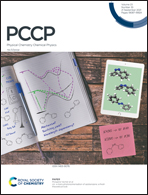Ultra-low thermal conductivity and high thermoelectric performance of monolayer BiP3: a first principles study
Abstract
The thermoelectric properties of monolayer triphosphide BiP3 are studied via first principles calculations and Boltzmann transport equation. First, the Seebeck coefficient, electrical conductivity and electron thermal conductivity at different temperatures are calculated using the Boltzmann transport equation with relaxation time approximation. It has been observed that BiP3 has a large power factor (265 × 10−4 W K−2 m−1, 700 K). Then, by analyzing the second-order interatomic force constant (IFCS), the atomic structure and phonon dispersion were studied, and the thermal conductivity of monolayer BiP3 was predicted in the temperature range of 300–800 K, and it was found that it had a very low thermal conductivity (2.13 W m−1 K−1) at room temperature. The thermal conductivity is mainly contributed by the branches of acoustics along in-plane transverse (TA). Finally, the maximum ZT value of monolayer BiP3 is 3.06 at 700 K, when the electron doping concentration is 2.35 × 1011 cm−2, which indicates that it is a promising thermoelectric material.



 Please wait while we load your content...
Please wait while we load your content...